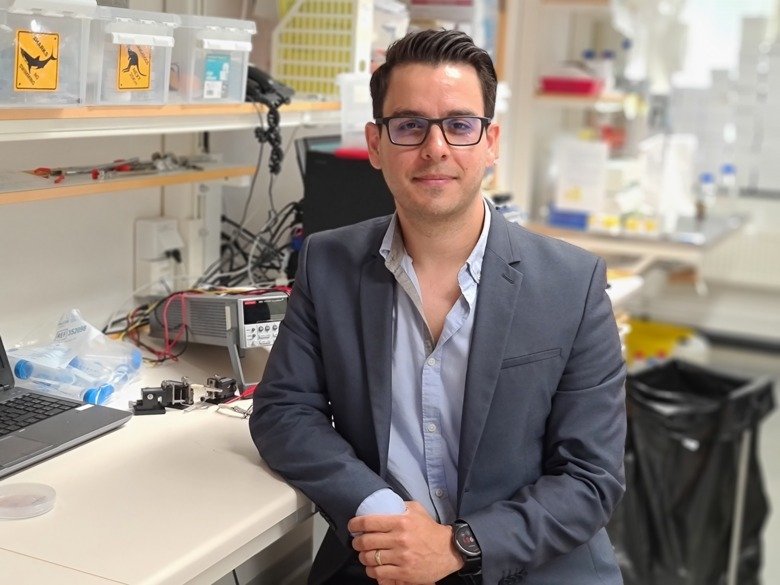How everyday gadgets can monitor your health

Smartphones and other portable electronics have changed our habits and our society in a couple of decades - but within medicine, the development has only just begun. Everyday gadgets that monitor our health open up new ways to detect, prevent and treat disease - but also raise questions.
Text: Anders Nilsson for Medicinsk Vetenskap nr 2, 2023
It is called wearable technology, or wearables for short. Small sensors placed on the body that measure, for example, movement, heart rate, ECG, blood oxygen levels, sweating, pH or specific substances, such as salt ions or hormones.
For consumers interested in fitness and health, there is now a wide range of fitness watches, wristbands and other equipment with such features. Within medicine, progress has been slower, but in the long term, wearable technologies can make a huge impact on healthcare. Imagine a future where every new doctor's appointment gets off to a flying start because all the important data is already collected during the patient's daily life.
On the other hand, imagine a future where our biology is under constant surveillance and huge amounts of privacy-sensitive health data must be stored and shared properly, without being leaked or misused. There is material for both bright dreams of the future - and nightmares.
Later in the article, we will meet researchers who are developing the medical wearable technologies of tomorrow. But we start where the revolution has already happened: in diabetes care.
Automatic insulin pumps improves quality of life
Electronic glucose meters and insulin pumps are not new as separate devices, but the last decade has seen a major step forward: they have been joined into a system that independently regulates the dosage of insulin. The glucose meter on the upper arm wirelessly sends readings to the pump, which adjusts the dose accordingly. This is repeated approximately every five minutes, around the clock, in a closed loop of adjustment and feedback. The solution is therefore often called closed loop. The carrier of the device will need to flag for meals and more intense physical activity but can otherwise engage in activities other than thinking about their insulin dosage.

Anna Lindholm Olinder is a researcher at Karolinska Institutet's Department of Clinical Research and Education, Södersjukhuset, and a diabetes nurse at Sachsska Children and Youth Hospital. In both her professional roles, she has seen the great improvements of the new insulin pumps.
“This is an extremely important change, both medically and in terms of the quality of life of patients and their relations,” she says.
The medical benefits are more consistent blood sugar levels and lower so-called long-term blood sugar level, HbA1c. It reduces the risk of both acute complications and long-term sequelae of diabetes.
The improvements in quality of life are partly due to the fact that closed loop pumps make life easier in practice, and partly due to an increased sense of safety and control.
“Perhaps most importantly, the quality of life has improved for parents of children with diabetes. They no longer need to get up one or more times a night to check glucose and adjust the dose," says Anna Lindholm Olinder.
More applications are expected
“In the future, there will be many solutions within wearable medical technology that will improve healthcare as much as the new insulin pumps,” reckons Onur Parlak, a researcher in bioelectronics at the Department of Medicine, Solna, at Karolinska Institutet.

“Fifty years ago, glucose meters were big machines in laboratories, today they are a patch on the arm,” he says. The same development is underway for many types of medical measuring equipment. And progress is fast. When I entered this field ten years ago, it had barely taken shape, but today certain clinical applications have already been achieved.
What do you think will happen in the long term?
“I would say our first major goal is rapid, personalised diagnostics. That you do not have to go to the doctor to take samples in case of an infection, because a sensor you have at home has already found what you are infected with. This is feasible for a large proportion of common healthcare tests.
A more advanced goal for wearable technology is to collect long series of measurements that we can use to learn how to predict future disease,” continues Parlak. “Patterns that we do not know today, but which can emerge when you have huge amounts of data to work with. It is a more complex task, but given the rapid developments in AI, it does not seem unrealistic.
Raises questions about data security
It is important that the new technology is deployed responsibly,” says Onur Parlak.
“Data security is the really big issue,” he says. We are talking about extremely privacy-sensitive surveillance on a large scale. Society needs to set clear rules on the storage, ownership and sharing of this data.
Another dilemma is that there will be a lot of data generated that lay people do not fully understand and may be concerned about.
“Imagine parents interpreting something worrying in their children's healthcare data,” says Onur Parlak. “Personally, I do not know if it is really necessary for us to access all our individual data from wearable technologies.
His own research involves wearable electronics for a variety of medical purposes, including stress measurements and detecting epileptic seizures. One project concerns wounds that are not healing.”
“Unfortunately, wounds that will not heal are a common problem in healthcare. We are trying to develop a smart patch that measures a number of factors in the wound such as the level of inflammation, temperature, pH and bacterial growth. This allows you to monitor what is happening in the wound in a way that does not interfere with healing and does not require a lot of healthcare resources. The idea is for the wearer to have an app on their phone that tells them when it is time to change the patch or if there is an infection that needs to be treated. In the longer term, it is conceivable that the patch itself delivers medicines directly into the wound when needed.
The development of wearable technology is part of a larger trend towards many more sensors around us in our daily lives,” explains Onur Parlak. Some work best when fitted on the body, others elsewhere. Gadgets that monitor our sleep are best placed by the bed and it is most reasonable to place sensors for analysing urine in the toilet.
Facts: Bioelectronics
Branch within technology, combining knowledge from electronics and biotechnology. The most important area so far is the development of biosensors.
Source: NE.se

“In one of my projects, we are developing a new incubator mattress for premature babies. It will monitor glucose and lactic acid in the blood without penetrating the skin. Today, these children need quite frequent blood tests, which is not great for several reasons.”
An important part of Onur Parlak's research involves developing new sensors, such as new materials that recognise a particular substance. To work in wearable technology, the sensors must be very small, power efficient, and not deteriorate too quickly.
“Sustainability is one of our most difficult challenges, both in my own research and for the whole research field. Many sensors responding to a particular molecule change simultaneously. After a while, they become saturated and less sensitive. Therefore, we need to add mechanisms to keep them alert.”
What do you do if you want to measure several factors?
“Each sensor can only measure one thing, but they are so small that it is easy to position many next to each other. Look at this!”
He holds up a small white circle, a few centimetres in diameter. Underneath are eight black rectangles in a row, each a few square millimetres in size.
“This plate is placed on your skin and analyses your sweat as you exercise. Each small box is a separate sensor. It measures glucose, lactate, sodium, potassium, electrical conductivity and more.”
How do you feel about the fitness companies developing all these fitness gadgets with sensors? Is their existence an advantage or disadvantage for your research?
“A bit of both. The downside is that they make us in academia appear slow,” laughs Onur Parlak. “Medical research is highly regulated; we cannot take any shortcuts. Those who develop consumer products for healthy people have a different freedom. I use a fitness watch myself and basically I have a positive attitude towards these companies, but not everything they do is of high quality. Some things they measure because it is easy, not because the measurements contribute with anything interesting.
A key benefit of the large market for fitness technology is that people are getting used to using wearable electronics,” he says.
“If you have already been using a fitness wristband for a long time, it is probably not a big step the day your doctor may suggest you start using something similar.”

Sensors detects epileptic seizures
Benno Mahler is a neurologist and researcher at the Department of Clinical Neuroscience at Karolinska Institutet within the field of epilepsy. Like Onur Parlak, he is involved in research on wearable technology for detecting epileptic seizures.
“Within the epilepsy work at Karolinska University Hospital, we have recently participated in a European multicentre study where about ten clinics tested small portable prototypes from a commercial manufacturer,” Mahler explains.
“Four types of sensors detect movement plus EEG, ECG and EMG - electrical activity in the brain, heart, and muscles respectively. The EEG is recorded with two or three electrodes behind the ear. The use of multiple variables should make the detection more reliable than the products already on the market,” explains Benno Mahler.
“The alarms that exist today usually rely solely on one variable, leading to a greater risk of false alarms. Some alarms may sound when you brush your teeth or play cards, for example.
A conventional way of recording epileptic seizures is for the patient to keep a seizure diary for a period of time. This will form the basis of the doctor's assessment of things like medication dosage or suitability for a driving license.”
“But patients with the most common form of epilepsy on average fail to record about half of their daytime seizures and up to 80 percent of those that occur during sleep,” says Benno Mahler. Wearable, discrete seizure detection devices would therefore be very valuable for the treatment of epilepsy. It can also be very useful in, for example, medicine studies, where high reliability is important.
The next big step in the development of wearables for epilepsy would be technology that instead warns prior to a seizure. However, Benno Mahler believes that for most forms of epilepsy, that road is still very long.
“In some types of epileptic seizures, signs of brain activity occur before the patient realises that the seizure is commencing - something the technology could address. But in many cases we do not see such warnings and that of course makes it more difficult,” he says.

Watch records atrial fibrillation
Cardiologist Emma Svennberg uses wearable technology in her research on atrial fibrillation at the Department of Medicine, Huddinge at Karolinska Institutet.
“When I started my research ten years ago, we used “thumb ECGs”, a device that is a few decimetres in size and is held with both hands so that ECGs can be recorded from the thumbs. It was the smallest and most convenient device at the time. Now similar functions are available in a watch that you wear around your wrist,” she says.
Atrial fibrillation affects many older people and increases the risk of stroke - a risk that can be prevented with medication. But this assumes that the condition is detected.
“Therefore, I wanted to investigate how many older people are walking around with atrial fibrillation without knowing it,” explains Emma Svennberg. This turned out to be around 3% of all 75-year-olds. The fact that my subjects were able to carry the equipment around with them and take many ECGs throughout the day meant that we detected significantly more cases than seen in previous studies.
Today, her research focuses on identifying these patients even earlier, before the fibrillation is established.
“We continue to collect ECGs from wearable devices and will use AI to try to identify patterns associated with future disease.”
As a cardiologist, Emma Svennberg sees great benefits in the development of wearable technology - but also challenges and risks.
“There is a huge potential for both patients and healthcare providers. The patient gets more control: Have my fibrillations returned? I can easily check it myself whenever I want! And for us in the healthcare sector, it is a great help if patients can learn from their device when they need to seek care, and already have relevant health data collected when they arrive at our clinic.
But this development also places demands on healthcare,” she points out. “This requires preparation, otherwise the new technology will be more of a burden.
We need digital structures to effectively manage these data sets, and we need to learn how to deal with data from different consumer products,” she says. “We do not want healthy people to take up healthcare resources because they observed a harmless anomaly in their fitness watch - but neither do we want someone who really needs care not to be taken seriously.
It is difficult to draw a clear quality line between medical wearable technology and consumer products,” she says.
“The sophistication of consumer products varies. Quite a few are simple, but when it comes to the more advanced models, my impression is that the manufacturers are quite serious and thorough. Major brands like Fitbit and Apple watch have their ECG measuring technology approved by the FDA - the US medicines agency that also regulates medical devices.”
She notes that consumer wearable technology is so far largely used by healthy, health-conscious people.
“The real benefit will come when this technology becomes mainstream and reaches a wider audience,” she concludes.
About the magazine Medicinsk Vetenskap
 Photo: Jens Magnusson
Photo: Jens MagnussonRead more articles about medical research
Read about the latest in medical science in Karolinska Institutet's Swedish language popular science magazine Medicinsk Vetenskap. Subscribe now!
